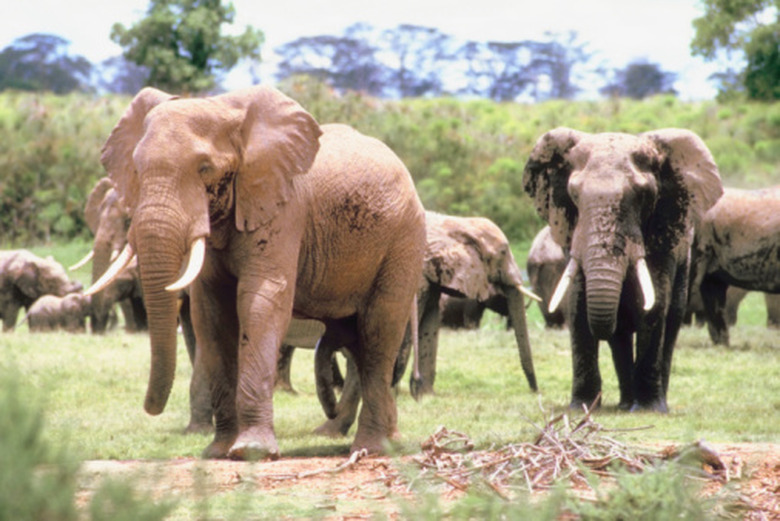What Are The Kingdoms That Contain Multicellular Organisms?
Living organisms are frequently divided into five kingdoms. Multicellular organisms fall within three of these kingdoms: plants, animals and fungi. Kingdom Protista contains a number of organisms that may at times appear multicellular, such as algae, but these organisms lack the sophisticated differentiation typically associated with multicellular organisms. The organisms within these kingdoms seemingly vary greatly, but at the cellular level, they share a number of features and are generally considered far more closely related to each other than to bacteria.
Eukaryotes
Eukaryotes
Organisms may be characterized by cellular features as either prokaryotes or eukaryotes. Eukaryotes possess linear chromosomes, a membrane-bound nucleus and complex organelles. Prokaryotes possess a circular chromosome and lack the sophisticated organelles and nucleus present in eukaryotes. It is important to note that all multicellular organisms are eukaryotes, though not all eukaryotes are multicellular.
Kingdom Animalia
Kingdom Animalia
As members of this kingdom, people are generally very familiar with the animal kingdom. In addition to being multicellular, animals are heterotrophic, lack cell walls, and develop from a blastula—a sphere of cells formed early in embryonic development. Although many animals are large, such as whales and elephants, some animals are extremely small such as mites that live in our eyebrows. A few animals have formed symbiotic relationships with autotrophs such as that found in corals. Although corals are small individually, their collective efforts over long periods of time have created truly massive features such as the Great Barrier Reef off Australia's coast.
Kingrom Plantae
Kingrom Plantae
Kingdom Plantae—which includes mosses, ferns, conifers and flowering plants—plays a significant and fundamental role in many terrestrial ecosystems as the first step of many food webs. Chloroplasts give plants their characteristic green color and enable plants cells to convert sunlight, water and carbon dioxide into food through photosynthesis. Another feature of plant cells is a cell wall composed of cellulose. Plants exhibit a much greater aptitude for asexual reproduction than animals. This ability is illustrated by Pando, an aspen in Utah that is an organism with an interconnected root system and over 47,000 stems cloned from a single parent. This has enabled Pando to survive since before the last Ice Age.
Kingdom Fungi
Kingdom Fungi
Both the single-celled fungi used to produce antibiotics, beer and soy sauce and the multicellular versions whose fruiting bodies appear atop our steaks are heterotrophic. Unlike animals that ingest their food and nutrition, fungi absorb their energy and nutrients from their environment by secreting enzymes. Fungi play an important role in the environment as decomposers, breaking down the waste and dead bodies of other organisms. Some fungi form symbiotic relationships with other organisms as in lichens (with algae) and mycorrhizae (on plant roots). However, some fungi can be parasitic.
Kingdom Protista
Kingdom Protista
It might be fair to characterize Kingdom Protista as the miscellaneous drawer for eukaryotes. Although many protists are single-celled, mulitcellular algae are sometimes placed within this kingdom alongside the single-celled algae. Differences between algae and plants include the lack of specialized body parts. Perhaps the most vivid example of multicellular algae lies in the kelp forests in some coastal areas. Though the kelp has parts analogous to the roots, stems and leaves, the holdfast of kelp lacks the sophistication and specialization found in the root tissues of plants. Algae often inhabit freshwater and marine environments but have also adapted to life in soil and in lichens. Algae are autotrophic using photosynthesis to make their own food just like plants.
References
- Online Biology Book; Kingdoms of Life; M. Farabee; 2002
- University of California Museum of Paleontology: Introduction to the Eukaryota
- Utah State Today; USU Scientists Study World's Largest Organism and Why Its in Peril; M. Muffoletto; Sep 2010
- Wayne's Word; Five Kingdoms of Life; W.P. Armstrong; 2008
- University of the West Indies: Algae; C. Carrington; 2004
Cite This Article
MLA
Chandler, David. "What Are The Kingdoms That Contain Multicellular Organisms?" sciencing.com, https://www.sciencing.com/kingdoms-contain-multicellular-organisms-8580792/. 24 April 2017.
APA
Chandler, David. (2017, April 24). What Are The Kingdoms That Contain Multicellular Organisms?. sciencing.com. Retrieved from https://www.sciencing.com/kingdoms-contain-multicellular-organisms-8580792/
Chicago
Chandler, David. What Are The Kingdoms That Contain Multicellular Organisms? last modified March 24, 2022. https://www.sciencing.com/kingdoms-contain-multicellular-organisms-8580792/
